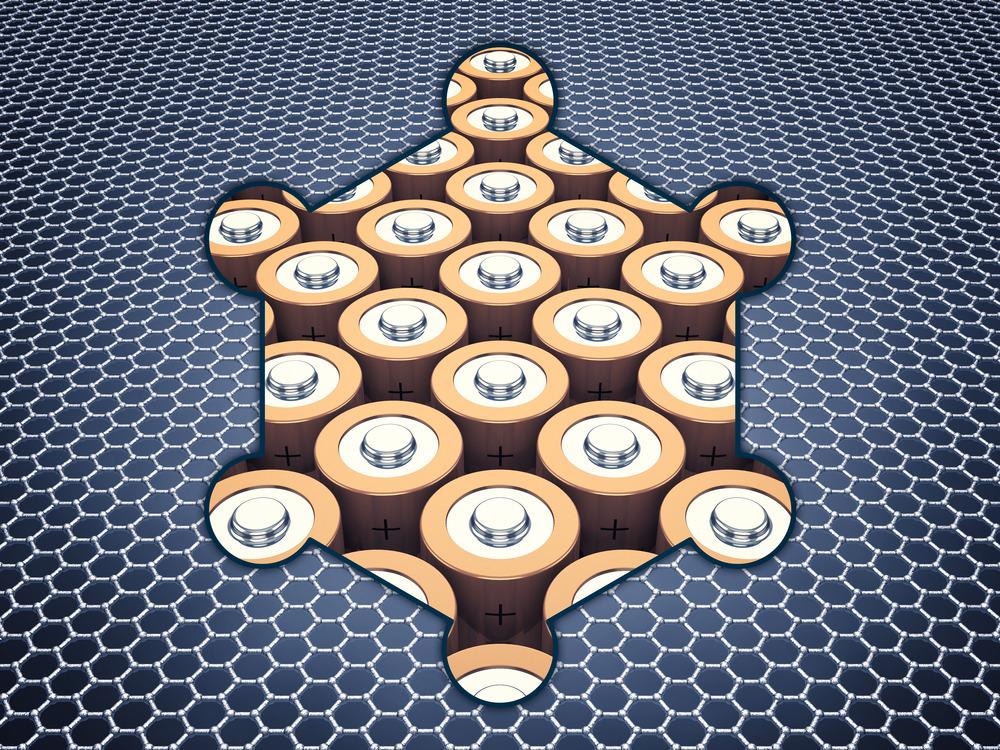A review published in Materials Today: Proceedings describes graphene-based nanocomposite fabrication methods, morphological layouts, and mechanistic aspects of electrochemical energy storage (EES) tools derived from graphene-based nanocomposites.

Study: Graphene nanocomposites and applications in electrochemical energy storage materials. Image Credit: nobeastsofierce/Shutterstock.com
The review covers technologies like supercapacitors, Lithium-ion batteries (LIBs), and hybrid supercapacitors, offering a glance into the possible improvements to aid future applications.
EES Devices for Clean Energy
Moving to clean and green energy technologies is a critical measure that must be taken as soon as possible to preserve the planet from the threats posed by pollutants, and the impacts of depleting fossil fuel supplies.
Electrochemical energy storage (EES) systems provide a potential answer.
Generally, Li-ion batteries, supercapacitors (SCs), and hybrid supercapacitors have been the three critical devices that have been the center of attention as far as EES systems are concerned. However, due to their poor effectiveness such as insufficient energy densities, subpar power densities, and short lifetime, LIBs and SCs are currently incapable of meeting industrial expectations for electronics products, smart power grids, electric cars, and renewable energy sources.
Graphene-based nanocomposites have shown their ability to execute EES tasks while overcoming the restrictions of traditional EES devices.
How Can Graphene Help
Graphene is a nanoscale material made up of a one atom thick sp2-bonded carbon structure arrayed in a hexagonal pattern, with a crystalline structure, electrical characteristics, and a variety of useful chemical and physical properties.
These qualities include excellent heat and electricity conduction, enhanced intrinsic carrier movement, enhanced hypothetical specific area, elevated light transmittance, good elasticity, low weight, and remarkable mechanical toughness, allowing for greater storage of electrical charges, ions, or hydrogen.
Graphene and the electrochemical component of nanocomposites enhance one another's characteristics, improving the total EES facets of the devices.
LIBs of graphene-based nanocomposites have seen extensive investigation. Thus far, the EES effectiveness has been attributed to the existence of sufficient surface area, remarkable conductance, and nano-pored design.
Graphene acts as an active element in the anode, where it accommodates lithium ions and forms linked routes for charge transportation.
The cathode's major role is to increase conductance in polyanions and spinels that would otherwise be poor conductors.
Graphene in the complex also helps to retain the integrity of the structure and elasticity by compensating for volume changes throughout the charging and discharging cycles. However, optimizing the mass ratio of graphene is critical to avoid any blocking of lithium-ion movement.
Different Methods of Fabricating Graphene
Obtaining the proper size of graphene is a common challenge for scientists. Various processes for graphene fabrication have been extensively researched internationally, such as the scotch-tape procedure, chemical vapor deposition (CVD), liquid-phase exfoliation, graphene oxide (GO) reduction reactions, unzipping carbon nanotubes, and thermal breakdown of silicon carbide.
CVD is the most effective technique for producing graphene of good quality. However, considering its drawbacks, it is less desirable.
Chemical exfoliation is an excellent choice for scalable implementation. It may also be coupled with mechanical exfoliation to produce the highest grade, purest, and inexpensive graphene.
Graphene fabrication, size management, nanocomposite design, quantity management, and functionalization are all in the early stages of exploration. Strategies from various fields of study, including physics, chemistry, electrochemistry, materials science, molecular interplay, and nanostructure study, should be undertaken and combined in tandem to obtain the best and quickest results. This is while bearing in mind the rapidly diminishing supply of fossil fuels.
Nanocomposite-based supercapacitor usage necessitates the availability of a large specific area and numerous pores.
Graphene nanocomposites have resultingly exhibited varying morphological shapes, dimensionality, and porosity. However, optimizing pores and packing density is a critical topic of study that must be thoroughly researched before commercial production to combine all of the beneficial qualities without compromising any physical aspect relevant to energy storage function.
Future Prospects in the Field of Hybrid Supercapacitors
Upcoming trends of supercapacitor design are likely to be hybrid supercapacitors based on graphene nanocomposites, which are ideally equipped to meet the pressing requirement for highly effective EES devices.
With the advancement of hybrid SCs, the limits of SCs appear edge of disappearing. Hybrid SCs are distinctive in the sectors of renewable and sustainable energy systems, as well as electric cars, due to their broad application and improved rate achievement.
Tuning the porosity of graphene, enhancing the conductance of the parts, and enhancing the geometrical characteristics of hybrid SCs will assist to discover greater possibilities for boosting their energy and power densities and cyclic stability.
Reference
Chaudhuri, A., Chaudhuri, A., & Joydhar, A. (2022). Graphene nanocomposites and applications in electrochemical energy storage materials. Materials Today: Proceedings. Available at: https://www.sciencedirect.com/science/article/pii/S2214785322008574?via%3Dihub
Disclaimer: The views expressed here are those of the author expressed in their private capacity and do not necessarily represent the views of AZoM.com Limited T/A AZoNetwork the owner and operator of this website. This disclaimer forms part of the Terms and conditions of use of this website.